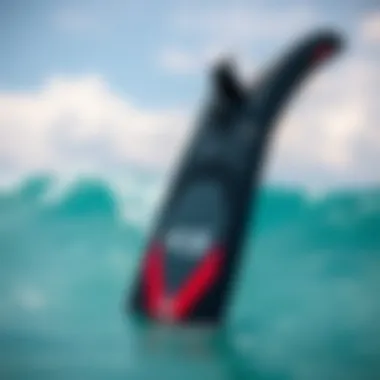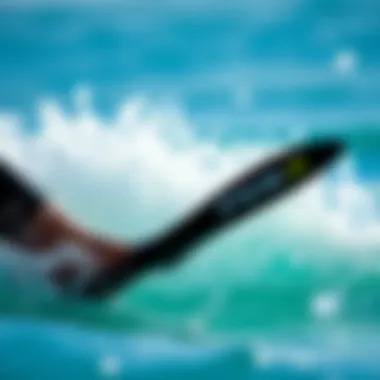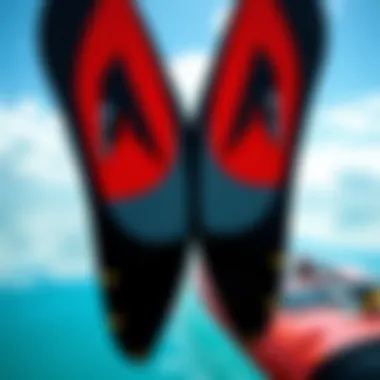Exploring the FCS 2 Quad Fin System for Watersports


Intro
In the world of watersports, having the right gear can make all the difference between a mediocre outing and an extraordinary day on the waves. One such essential component in a water enthusiast's toolkit is the fin system. Among the various options available, the FCS 2 Quad fin system stands out for its remarkable versatility and performance enhancement capabilities. Designed to cater to surfers, paddleboarders, and kitesurfers alike, this fin setup provides an optimal balance between speed, maneuverability, and stability, allowing riders to achieve their best performance depending on the conditions.
The FCS 2 Quad system isn't just a piece of equipment; it's an innovation rooted in years of extensive research and user feedback. By exploring the design features, performance traits, and practical applications of this fin system, we will equip you with the knowledge necessary to decide on your gear. Whether you're a seasoned pro or just dabbling in watersports, understanding the FCS 2 Quad can significantly enhance your experiences on the water. So, grab your board, and let's dive into this detailed analysis of a fin system that could very well be the game-changer you need for your aquatic adventures.
Understanding the FCS Quad Fin System
The FCS 2 Quad Fin System has gained significant traction among watersport enthusiasts due to its unique configuration and benefits. Understanding this fin system is essential for anyone looking to enhance their performance while surfing, paddleboarding, or kitesurfing. Unlike traditional setups, the quad fin arrangement offers a different experience that can dramatically influence how a rider interacts with water.
Foreword to FCS Fin Systems
FCS, short for Fin Control System, is a pioneering brand in windsurfing and surfing fin technology. Their design philosophy revolves around providing versatility and performance enhancement for a wide range of water conditions. Each fin system is engineered to deliver unique strengths, allowing users to adapt their gear according to the waves or winds they face. The FCS 2 system notably enhances the ease of changing fins, making it user-friendly and perfect for those who enjoy experimenting with their setup.
FCS fin systems are vital for optimizing the connection between surfboards and water, which directly affects ride quality. When considering such systems, it’s important to realize that not all fins are created equal. The shape, size, and material all contribute to how effectively a fin can perform while in use.
Defining the Quad Setup
The quad fin setup distinguishes itself by strategically positioning four fins on the board—two in the rear and two towards the front. This arrangement not only promotes speed but also enhances maneuverability in tricky waters. For surfers, this translates to sharper turns and quicker acceleration, especially when catching smaller waves or when faced with choppy conditions.
For kitesurfers and paddleboarders, the benefits of a quad setup remain compelling. The added stability is a game-changer; it allows riders to maintain control, even when wind conditions become unpredictable. In essence, the quad fin configuration is like adding a second pair of hands for a watersport enthusiast, providing that extra grip and assist when it’s needed most.
A few highlights of the quad fin setup include:
- Increased Speed: With two more fins in the water, these boards can pick up speed without compromising control.
- Enhanced Maneuverability: The strategic placement of fins enables more fluid turns and easier navigation through waves or currents.
- Stability in Rough Conditions: This setup can help keep a board steady when faced with unpredictable wave patterns or sudden gusts of wind.
"The right fin setup isn't just a matter of preference; it's crucial to the entire riding experience. Picking the FCS 2 Quad can help maximize that experience by aligning the board's strengths with the rider's style."
In sum, grasping the fundamentals of the FCS 2 Quad Fin System is not only advantageous but critical for optimizing one’s time on the water. Enthusiasts must understand the balance between control, speed, and stability that this fin arrangement can deliver. Being well-versed in these elements sets the stage for a more fulfilling and exhilarating ride.
Technical Aspects of FCS Quad Fins
Understanding the technical aspects of the FCS 2 Quad fin system is crucial for watersport enthusiasts who seek optimal performance. These elements not only impact how the board maneuvers on different waters, but they also influence the overall experience of riding, helping to tailor it to specific conditions and personal preferences.
Material Composition
The material makeup of the FCS 2 Quad fins is pivotal in establishing their resilience and performance. Typically, these fins are constructed from materials such as fiberglass, plastic, or even more advanced materials like carbon fiber.
- Fiberglass fins provide a nice balance of flex and durability. They tend to offer a smoother ride, suitable for various wave conditions.
- Plastic fins, on the other hand, are easier on the wallet and come in various colors. While they might not deliver the same performance level as fiberglass or carbon fiber, they are a solid choice for beginners or casual surfers.
- Carbon fiber fins are the high-end option, lightweight, and provide exceptional performance. They offer an unparalleled combination of stiffness and lightweight design which can enhance speed significantly.
When selecting fins, enthusiasts need to consider their specific riding styles and conditions. For example, a carbon fiber fin might be ideal for a kitesurfer looking to rip through strong winds, while a beginner paddleboarder could benefit from the forgiving characteristics of a plastic fin.
Design Features
The design of the FCS 2 Quad fins plays a critical role in how they interact with the water. This specific fin system features a unique attachment mechanism that ensures the fins are held firmly in place without any slippage during rides. Key design features include:
- Flex Patterns: This aspect determines how much the fin bends under pressure. Fins with more flex are great for maneuverability, while stiffer fins generally enhance speed.
- Base Width: A broader base allows for better stability, particularly helpful in choppy waters. Conversely, narrower fins might favor more agile and responsive handling, favored by experienced surfers.
- Foil Shape: The foil describes how the fin slices through water, impacting drag and lift. Most FCS 2 Quad fins are designed with specific foil shapes that cater to different styles of riding, whether it’s for executing quick turns or maintaining speed.
Fin Profiles and Shapes
The profile and shape of fins can greatly influence performance. FCS 2 Quad fins typically come in several shapes, each suited for different riding conditions and preferences:
- Raked vs. Upright: Raked fins, angled back, tend to be better for generating speed and fluidity in turns. Upright fins, however, offer more grip, enabling sharper turns and maneuvers.
- Height: The height of the fin affects how much water is displaced. Taller fins can offer more drive and grip but may also create more drag. Shorter fins facilitate quick moves and agility.
- Width and Surface Area: Fins with more surface area provide more stability and can loosen up the ride when needed. Smaller fins allow for a more dynamic and playful experience, particularly suited for radical moves.
Overall, it’s essential to experiment with different fin shapes to find what works best for individual style and the types of conditions riders commonly face.
"The right fin choice can mean the difference between a memorable day on the water and one that’s forgettable, especially when conditions change."
In summary, the technical aspects of the FCS 2 Quad fins are integral to optimizing performance across various water sports. Understanding material composition, design features, and fin profiles can empower users to make informed decisions that elevate their aquatic experiences.
Advantages of Using FCS Quad Fins
The FCS 2 Quad fin system offers a multitude of advantages that cater specifically to the needs of watersport enthusiasts. This section delves into the notable benefits that make the quad setup appealing, elucidating specific elements such as speed, maneuverability, stability, and control that set it apart from other fin configurations. Understanding these advantages can immensely aid surfers, paddleboarders, and kitesurfers in making informed decisions about their gear.


Enhanced Speed and Maneuverability
One of the standout features of the FCS 2 Quad fins is their ability to promote enhanced speed and maneuverability. When you throw yourself into the waves, the last thing you want is to feel sluggish. The quad setup allows for a smoother flow of water, reducing drag significantly. This means you can catch waves more efficiently and keep your momentum going, which is vital when you're riding those thrilling swells.
- Streamlined Design: The shape of the fins is engineered to wedge finely into the water, creating a streamlined effect. Unlike a traditional thruster setup, which might slow you down, these fins cut through the water more effectively.
- Tighter Turns: Whether you’re carving down the line or navigating through choppy seas, the quad configuration allows for sharper turns without losing speed. Inline turns become easier, offering riders the ability to respond flexibly to shifting wave conditions.
Overall, the FCS 2 Quad fins empower enthusiasts with a dual advantage: the smooth ride of increased velocity and the agility to maneuver effortlessly across fluctuating terrains.
Improved Stability and Control
In the unpredictable world of watersports, stability and control are paramount. The FCS 2 Quad fins excel in providing both, offering users a sense of security that translates into confidence for more advanced techniques. The quad fin arrangement distributes pressure evenly, creating a more balanced experience, especially in turbulent waters.
- Balanced Performance: Since the two outer fins provide lateral stability and the two inner fins drive forward momentum, water sports enthusiasts benefit from a well-rounded performance. This arrangement prevents wobbling, which can be detrimental during sharp turns or rapid wave action.
- Enhanced Tracking: Riders often find that with a quad setup, they can maintain a straighter line toward their destination without excessive paddling. This is particularly beneficial in windier conditions when directional control becomes more challenging.
As a result, the FCS 2 Quad fins not only enhance your comfort level on the board but also empower you to push your limits while riding. With the right gear, you’re far more likely to enjoy a seamless experience on the water.
"Experience the freedom that a quad fin setup can offer. It's all about finding the right balance and control that allows the rider to focus on the ride itself."
Performance in Different Water Conditions
Understanding how the FCS 2 Quad fins perform in various water conditions is crucial for any watersport enthusiast looking to leverage their gear to its fullest potential. The unique design of the quad fin setup allows for enhanced versatility, which is particularly valuable when conditions aren't ideal. With that said, analyzing specific conditions can not only highlight the benefits of this fin system but also guide users in making informed choices based on their environment and style of riding.
Ideal Wave Types
The FCS 2 Quad fins shine particularly in certain wave types. Generally, these fins are best suited for:
- Sectiony, punchy waves: In these conditions, the fin setup allows for quick turns and sharp maneuvers, enabling surfers to exploit critical sections of the wave.
- Small to medium-sized waves: The quad configuration provides the necessary grip and stability, which empowers users to stay in control and connect turns without losing speed.
- Open-faced waves: The design facilitates smooth flowing lines, making it easier to generate speed and set up for big aerials or close-out maneuvers.
Utilizing the FCS 2 Quad fins on the right types of waves means users can maximize their performance, resulting in a more enjoyable and successful session.
Adaptability to Wind Conditions
When it comes to wind conditions, the FCS 2 Quad fins offer remarkable adaptability. Whether facing offshore winds that whip the water surface into a frenzy or onshore winds that can create bumpier conditions, this fin setup is engineered to handle various challenges.
Some crucial points to consider include:
- Offshore Winds: Surfers can rely on quad fins to maintain speed and minimize drag. Strong offshore winds tend to push water back, but the fins help significantly in maintaining board control.
- Onshore Winds: While onshore winds can create turbulence, quad fins maintain stability, allowing for more confident riding. The extra surface area aids in reducing slide, providing a consistent feel despite the winds.
- Crosswinds: In these situations, the ability of the fins to grip the water helps keep the board tracking straight, which is vital for remaining in control and focused.
In summary, being aware of how the FCS 2 Quad fins adapt across various water and wind conditions allows riders to adjust their tactics accordingly, ensuring a more successful and enjoyable experience on the water.
User Perspectives and Experiences
User perspectives play a crucial role when it comes to evaluating gear such as the FCS 2 Quad fin system. Feedback from actual users sheds light on real-world performance, which can be pivotal for enthusiasts deciding whether these fins suit their style of riding. This section dives into the various voices from the watersport community, highlighting their experiences and insights, and providing a nuanced understanding of the FCS 2 Quad fins.
Feedback from Experienced Surfers
When discussing the functionality of the FCS 2 Quad fins, the feedback from seasoned surfers is indispensable. Many experienced riders emphasize the increased speed and agility that these fins offer, particularly when tackling bigger waves. One veteran surfer shared, "Going from a thruster setup to the quad was like switching from a sedan to a sports car; the control and response were simply night and day."
- Key Aspects Experienced Surfers Mentioned:
- Responsiveness in Turns: Surfers find that the quad setup allows for tight, precise turns without losing speed.
- Versatility Across Conditions: Whether in choppy waters or smooth rides, users note that the fin system adapts quite well, enhancing their performance.
- Stability in Bigger Swells: The extra fins provide more grip, making it easier to ride larger and more challenging waves.
Insights from Paddleboard Users
Paddleboarders have also weighed in on the advantages of the FCS 2 Quad fins. Many of them appreciate how the fins affect their overall paddling experience and stability on the water. One paddleboard enthusiast remarked, "I felt like I was gliding smoother and could maintain my line much easier with the quad fins. The stability lets me focus on enjoying the scenery, rather than battling the board."
- Notable Comments from Paddleboard Users:
- Better Tracking: Users feel that the quad fins help with tracking in various water conditions, reducing drift.
- Enhanced Maneuverability: Many paddleboarders note that turning is easier, especially in tight spots.
- Comfort in Choppy Waters: The added stability makes paddling through choppier conditions less daunting.
Kitesurfers’ Experiences with Quad Fins
Kitesurfers provide another layer of insight into the FCS 2 Quad fins, having a unique perspective due to the combination of speed and agility required in their discipline. Many kitesurfers find these fins remarkable for handling the exhilarating acceleration off the water. A kitesurfer shared, "The quad fins let me power through the water without the board slapping down. It felt way more synchronized with my kite’s pull."
- Key Points Kitesurfers Noted:


- Lift and Speed: The quad system provides a good lift for jumps while maintaining speed on the board.
- Handling Slalom Turns: Many claim that these fins excel at slaloming and sharp turns, offering excellent responsiveness.
- Performance in High Winds: Users report feeling more confident in controlling their board when the wind picks up, thanks to the quad setup's stability.
The collective experiences from these watersport enthusiasts underscore the practical advantages of the FCS 2 Quad fin system, influencing how gear choices can significantly enhance performance in various aquatic disciplines.
In summary, feedback from surfers, paddleboarders, and kitesurfers illustrates that the FCS 2 Quad fins meet a range of needs, providing experiences that often exceed expectations. This kind of real-world insight can help others make informed decisions when considering their next gear upgrade.
Compatibility with Various Boards
Understanding how the FCS 2 Quad fin system interacts with different board types is crucial for maximizing performance. Each watercraft—whether it be a surfboard, paddleboard, or kitesurfboard—has its unique characteristics, and the right fin setup can make all the difference. This section sheds light on why compatibility matters and how it enhances your watersport experience.
Matching Fins to Surfboards
Choosing the right fins for your surfboard requires a keen understanding of both the board's design and the specific conditions you'll be riding. The FCS 2 Quad fins are particularly suited for shortboards and fish, offering an impressive blend of speed and maneuverability.
- Performance Characteristics: The two rear fins in the quad setup provide added drive when you want to punch through waves, while the two front fins create a balanced pivot point.
- Weight Distribution: Placing fins of varying sizes can affect how your board carries speed through turns. For instance, larger fins in the rear can aid in stability, particularly in choppy water.
- Personal Preference and Style: Some surfers favor a looser feel, while others prefer a more anchored ride. Matching your fin setup to your surfing style can elevate your performance, tailoring it to your needs.
In essence, a thoughtful fin selection tailored to your surfboard type significantly elevates the ride quality. Thus, whether shredding on small beach breaks or pumping through powerful swells, the right quad setup can help you maneuver with finesse.
Integration with Paddleboards
Paddleboards have starkly different dynamics compared to surfboards, primarily due to their size and intended use. The FCS 2 Quad fins play a critical role in ensuring effective maneuverability and tracking stability in various water environments.
- Tracking Ability: The quad setup allows for better tracking in flat water, making it easier to paddle in a straight line without excessive effort.
- Stability in Choppy Water: For those who enjoy touring or racing, these fins offer essential stability when navigating through rough seas.
- Experimentation is Key: Adjusting fin sizes and placements can lead to varying experiences. Heavier riders might find that larger fins provide the extra stability they need, while lighter paddlers might prefer smaller fins for a more agile performance.
Ultimately, when selecting FCS 2 Quad fins for paddleboards, be sure to assess how they fit with your own paddling technique and the types of water you're likely to encounter. This aspect is essential for those who seek efficiency in their paddling experience.
Using Quad Fins in Kitesurf Boards
Kitesurfing demands a whole other level of fin performance due to the unique combination of speed and lift involved. The FCS 2 Quad fins can add significant advantages when matched with kitesurf boards, enhancing control in more turbulent waters.
- Enhanced Grip: The quad configuration provides secure grip in various wave conditions, giving you the confidence to maneuver aggressively without losing control.
- Flexibility in Adjustments: If you're riding more choppy water often, you might want to consider larger fins to stabilize your board and enhance performance. On the flip side, if conditions are relatively calm, smaller fins might allow enhanced agility and speed.
- Rise and Jump Control: In kitesurfing, the ability to perform jumps and transitions depends greatly on control. FCS 2 Quad fins provide less drag while still offering enough grip to launch from the water effectively.
In a nutshell, incorporating FCS 2 Quad fins into kitesurf boards grants kitesurfers flexibility across different conditions. It allows them to tailor their setup based on their riding style and the challenges posed by the water conditions they face.
"In watersports, the fin is not just a tool; it's an extension of your skills."
Ultimately, selecting the right fins for your board is about more than just sport-specific performance; it’s about enhancing your overall experience and capability on the water.
Fin Maintenance and Care
Caring for fins is a crucial aspect that often gets overlooked in the watersport community. Whether you’re a surfer, paddleboarder, or kitesurfer, the longevity and performance of your FCS 2 Quad fins depend heavily on proper maintenance. A little bit of attention can go a long way in ensuring optimal performance and prolonging the life of your equipment.
Cleaning and Storage Tips
Maintaining the cleanliness of your fins should be a priority. Saltwater can be harsh and detrimental to the materials over time. After every session, take a few moments to rinse your fins with fresh water. This simple task helps remove salt, sand, and other debris that can cause corrosion or lead to breakage.
When storing your fins, avoid placing them in direct sunlight or in hot areas. Overheating can warp the shape and affect their performance. Instead, try to keep them in a cool, shaded, and dry place. Here are some additional storage tips:
- Use a fin bag: Invest in a padded fin bag to prevent accidental damage when transporting your gear.
- Keep them separate: Avoid stacking your fins on top of each other to prevent scratches and deformation.
- Inspect Regularly: Check for any signs of wear or potential issues before your next outing.
Replacement Guidelines
Knowing when to replace your fins is just as important as maintenance. Generally, fins can endure significant wear and tear, but there are clear indicators that signal replacements are due. Look out for the following:
- Cracks or chips: Any visible damage can significantly impact performance.
- Dulled edges: If the leading edge of the fins becomes worn down, they may not perform as intended.
- Altered shape: Warping from heat or impact can lead to stability issues.
If you notice any of these signs, it might be time to consider a new set. While FCS 2 Quad fins are designed for durability, they are not invincible. Being proactive about replacements ensures that you always have the best performance on the water.
"Regular care and mindful replacement of your fins are not just good practice; they are essential for maximizing your overall watersport experience."
For more tips, you can refer to reputable sources such as Surfer's Journal, or check community discussions on Reddit.
Comparative Analysis with Other Fin Systems
When it comes to watersports, the choice of fin system can make all the difference between riding the waves smoothly or struggling to stay on course. In this section, we take a closer look at the FCS 2 Quad fin system and how it stacks up against other popular fin configurations. Understanding these comparisons can help enthusiasts make more informed choices about their equipment, ultimately enhancing their performance on the water.


FCS Quad vs. Thruster Setup
The thruster fin setup, arguably one of the most prevalent configurations in surfing, consists of three fins: one center fin and two side fins. This arrangement offers a balance between speed, control, and versatility. However, when placed side by side with the FCS 2 Quad, we find some distinct differences that might sway your decision:
- Maneuverability vs. Speed: While the thruster setup allows for exciting turns and tricks, especially in smaller waves, the FCS 2 Quad fins bring a different flavor to the table. Their unique placement often enhances speed, particularly in larger swells, allowing riders to maintain momentum without sacrificing control.
- Stability: FCS 2 Quad fins boast greater stabilization due to the extra fin. Surfers often find that the four-fin configuration allows for a steadier ride in choppy or windy conditions, whereas the thruster setup may struggle with stability during larger waves.
- Adaptability: The quad configuration is more suited for a variety of water conditions. Whether you find yourself in small beach breaks or overhead surf, the FCS 2 Quad fins can adapt more effectively compared to the thruster setup, which may perform better in a narrower range of scenarios.
Ultimately, while thruster systems have their loyal followers and specific use-case strengths, the FCS 2 Quad stands out for its enhanced speed and stability, making it a strong contender for those looking to take on bigger and more variable surf.
FCS Quad vs. Single Fin Setup
On the other end of the spectrum lies the single fin setup. The simplicity of a single fin can be attractive, especially for those who prefer a classic surfing experience. However, this choice comes with its own set of trade-offs. Let’s break down the key differences:
- Control: One of the major shortcomings of a single fin is the limited control when making tight turns. The FCS 2 Quad, with its four fins, offers superior grip and responsiveness that can enhance a surfer's ability to dive into a pocket and execute sharper maneuvers.
- Volume of Speed: Single fin boards tend to favor flowing, smooth lines, which is fantastic for noseriding. But when the zone calls for some serious speed, the quad exhibits a marked advantage. Many riders report that they can slice through bigger waves with a quad that might not be as effective with just one fin.
- Wave Conditions: If you're maneuvering through smaller or mushy waves, a single fin could suffice. Yet, when the surf picks up and you need to perform, FCS 2 Quad fins shine, providing the edge needed to tackle unpredictable and challenging conditions.
"Fins may seem like just a small detail on a board, but they can drastically change the riding experience. Choosing the right setup aligns your board with your personal riding style and the conditions you face."
Links for Further Reading
For more insights on fin systems and their applications, check out these resources:
- Wikipedia on Surfboard Design
- Britannica on Water Sports
- Reddit Community on Watersports Gear
- Boarding community on Facebook
By evaluating each fin system's strengths and limitations, watersport enthusiasts can better understand what suits their style and the conditions they surf in.
Future Trends in Fin Technology
As watersport enthusiasts continuously seek enhanced performance and gear that suits their unique styles, the future of fin technology becomes an integral part of that quest. The FCS 2 Quad fin system has laid a solid foundation, but innovation is ever-present, pushing the boundaries of what’s possible. Embracing new trends and technologies is essential not only for improving performance but also for enhancing the overall experience on the water.
With growing demand for customized and high-performance gear, manufacturers are diving deeper into understanding user needs, which leads us to remarkable innovations and sustainability in fin design and production. Let's delve into what these future trends entail.
Innovations in Fin Design
The design of fins is not just about how they look but also how they function in the water. Emerging trends focus on several key areas:
- Shape Adaptability: Designers are now experimenting with adaptive shapes that can effectively respond to the fluid dynamics of different waters. New models allow for adjusting profiles while paddling, ensuring optimal performance whether you're on flat water or tackling waves.
- Smart Technologies: Some companies are now exploring the integration of smart materials that adjust stiffness based on conditions. These materials help to optimize drag and control, allowing the fin to adapt in real-time.
- Modular Fin Systems: A shift towards modular setups is surfacing, where users can easily combine different fin profiles as per their skill levels or water conditions. This unprecedented flexibility leads to more tailored performance.
By incorporating these innovations, manufacturers aim to create fins that not only meet the needs of various watersport activities but also resonate with the desire for personalization.
Sustainability in Fin Production
Today's environmental concerns prompt a closer look at how fins are produced. The conversation around sustainability is reality check that the watersport industry must acknowledge. Key aspects of sustainability include:
- Eco-friendly Materials: The shift towards using recycled plastics and bio-resins has expanded. Utilizing materials sourced from ocean waste not only contributes to sustainability efforts but also enhances brand loyalty among eco-conscious consumers.
- Carbon Footprint Reduction: Future trends emphasize minimizing the carbon footprint in production processes. Brands are actively seeking local sourcing of materials and partnerships that reduce transportation emissions, making their operations more environmentally friendly.
- Recyclable Fin Systems: As the demand for smart design grows, so does the idea that fins should be designed for end-of-life disposal. Systems that allow for easy recycling or repurposing of fins are gaining traction.
The commitment to sustainability can set brands apart. With enough momentum, adopting these practices could lead to a more responsible future for the watersports industry, aligning passion for the water with a love for the planet.
"The true test of a sports equipment lies in its ability to evolve and adapt with the times, balancing performance with responsibility."
Finale and Recommendations
In the world of watersport, the right gear can make or break the experience. The FCS 2 Quad fin system is no exception. As this article has showcased, it brings a unique blend of versatility, performance, and user adaptability that appeals to a wide range of water enthusiasts—from surfers tackling gnarly waves to calm paddleboard adventurers. Understanding this advanced fin system wraps back around to more than just hardware; it's about enhancing one’s overall ride.
This fin setup is primarily notable for its ability to provide enhanced speed and maneuverability. Many users have reported noticeable differences in how quickly they can navigate through varying water conditions, suggesting that investing in a good fin system is akin to having a quality engine in a car. Adding to that the profound improvements in stability and control opens up pathways for both seasoned athletes and novices alike to elevate their performance.
Lastly, considering the various board compatibilities and technical maintenance aspects discussed previously, it’s clear that optimal care and knowledge can promote longevity and durability. Thus,
- Regular cleaning is a simple yet effective practice that keeps your fins in pristine condition.
- Choosing the right board type to pair with the fins cannot be overlooked; it’s about forming a synergy between your setup.
- Lastly, one should never underestimate the influence of customer feedback on selecting fins that fit your specific style and needs.
In summation, the FCS 2 Quad fin system represents not just a choice of fin but an enhancement to your entire watersport adventure. Ensuring that you are equipped with the right fins is essential for maximizing performance and enjoyment on the water.
Final Thoughts on FCS Quad
As the curtain curtain draws on our exploration of the FCS 2 Quad, it is essential to take a moment to reflect on its essence in the broader context of watersports. The system is not merely about fins; it captures the spirit of innovation and adaptability in a sport that continues to evolve. Surfers who are used to traditional setups may find transitioning a bit tricky at first, but the superior performance and customization options offered can make the switch well worth it. Ultimately, the FCS 2 Quad system stands as a testament to what's possible when design meets function.
Advice for Choosing Fins
When diving into the selection of fins, several pivotal factors should guide your decision-making process:
- Understand Your Style: Whether you're looking to carve, catch air, or paddle seamlessly across calm waters, knowing your riding style is key.
- Consider Conditions: Different environments warrant different setups. For choppy or messy surf, stability is a priority, whereas smaller, clean waves might prompt a setup that prioritizes speed.
- Test Before You Commit: Whenever possible, try before you buy. Many shops offer demo days or rental options, allowing prospective buyers to get a feel for how various fins perform.
- Talk to Other Users: Engaging with fellow enthusiasts or reading online reviews can lend insights and experiences that might not be available otherwise.
Navigating the waters of fin selection can seem daunting, but when equipped with knowledge and a clear understanding of one's objectives, the right choice becomes a more achievable feat.



